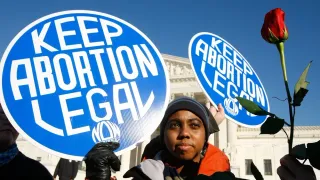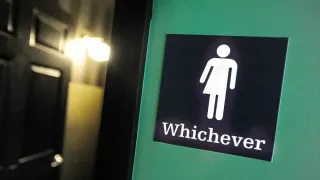July 5, 2014
History: 'Zaps' Were Stunts to Bring Attention to Gay Rights
Kilian Melloy READ TIME: 4 MIN.
It was 1973 and Mark Segal, was sitting in the CBS studios watching America's most trusted newsman, Walter Cronkite, conduct the evening news live. A journalism student, Segal was given a pass into the tiny studio to learn more about broadcast - but he had much more planned that night.
With a single camera pointed at Cronkite, Segal quietly walked onto the stage after a commercial break, sat on the broadcaster's desk, and held up a sign for all of America to see: GAYS PROTEST CBS PREJUDICE.
Needless to say, CBS went black and Segal was wrestled to the floor and tied up with wires before being taken into a back room.
"America got to hear there was a gay rights movement," Segal said. "The following morning, we were in most American newspapers."
And that's exactly what he wanted. Segal and his Gay Raiders participated in scores of actions like the one at CBS, called "zaps." With the media largely ignoring the gay community or reporting on it with a negative slant, gay groups worked to get onto the news in various zaps. For Segal, this included handcuffing himself to a news camera, to the Liberty Bell, or locking his neck around the doors of the United Way building.
"If the media wasn't going to cover us, we were going to bash them, or in my case, zap it," Segal said. "We were about 'In your face motherfucker!' "
Zaps were a popular means to getting onto the news, and the women's liberation movement as well as other activists in the tumultuous '60s and '70s used it successfully.
"The zaps really were just one example of the kind of political action that occurred in the late 1960s in protest against the war, in protest against drug laws," said Florida Atlantic University Professor Fred Fejes, who specializes in the LGBT community and media. "The whole action was organized around getting the media to pay attention to it."
Richard Wandel came out at 24 and left behind his goal of becoming a priest. Instead, he would become a member of the Gay Activist Alliance.
Growing up in Queens, Wandel saw the discrimination against gays. On top of application for housing or employment, people would write "HCF" - high class fairy. Anyone who looked gay walking through Times Square would be harassed and arrested, especially during election years when politicians vowed to "clean up Times Square."
Walking home one day, Wandel encountered a demonstration that was organized at the square and decided to join in, including marching down to Greenwich Village. The march ended in a small riot.
"The police would retaliate by picking some small person in the front and beating the shit out of them," he said. "It gave me a real sense that something had to be done."
He became the president of the Gay Activists Alliance, participating in multiple zaps.
The alliance hounded New York Mayor John Lindsay, who was running for president, and his wife at the opening of the Metropolitan Opera season in 1970, shouting gay slogans and demand that he take a public stance on gay rights. They also disrupted the taping of his weekly television program, "With Mayor Lindsay."
The GAA also invaded ABC's headquarters after a series of homophobic episodes on "Marcus Welby, M.D.," including one that equated pedophilia to homosexuality.
In 1971, they picketed and conducted a sit-in at the Fidelifacts building - a private investigative agency that outed gays, the president claiming "If it walks like a duck, talks like a duck, it's a duck." So an alliance member dressed in a duck costume in front of the office, making it onto the news and ridiculing of Fidelifacts.
"We liked humor, but the aim of course is to be on the news, that's the whole point here," Wandel said. "You've got to get on the 6 o'clock news."
Wandel was arrested four times as a result of the zaps.
After Segal, who zapped Cronkite, was arrested, he bailed out and went to court a month later. During a break in the trial, Segal stepped outside with his lawyer when he felt a tap on his shoulder. It was Walter Cronkite.
The two talked about the bias in CBS's reporting, with Segal giving multiple examples, such as the underreporting of gay rights legislation, that Cronkite refuted. Even so, the next week, Cronkite pulled up a map of the United States and listed off the dozens of cities that had recently passed gay rights protections.
Segal was found guilty of trespassing and fined $200. Even after their odd encounter, the two remained friends.
"Until his dying day he would never admit that he was wrong," Segal laughed.
And the zaps didn't stop.
Later, Segal used an ABC gold pass to interrupt taping of about eight television shows, allegedly costing $785,000 in tape delays, about $1 million today.
"More than half the game is how the media represents [you], and so they found that in terms of political awareness and political action that a fair amount of the action has to be directed at the media," Fejes said of the zaps.
Today, Segal is living in Philadelphia, his hometown, where he is the founding editor of the Philadelphia Gay News. Wandel is still in New York City, running the LGBT Community Center National History Archives, which he founded 24 years ago.
Two fighters in the revolution for gay rights, the two continue their advocacy by telling their stories and living through times where issues such as gay marriage and serving in the military were things they could never imagine.
"It was an awful lot of fun," Wandel said. "I'm very proud to have been a part of this, to say the least."
Kilian Melloy serves as EDGE Media Network's Associate Arts Editor and Staff Contributor. His professional memberships include the National Lesbian & Gay Journalists Association, the Boston Online Film Critics Association, The Gay and Lesbian Entertainment Critics Association, and the Boston Theater Critics Association's Elliot Norton Awards Committee.

 Copyright South Florida Gay News. For more articles, visit
Copyright South Florida Gay News. For more articles, visit 





